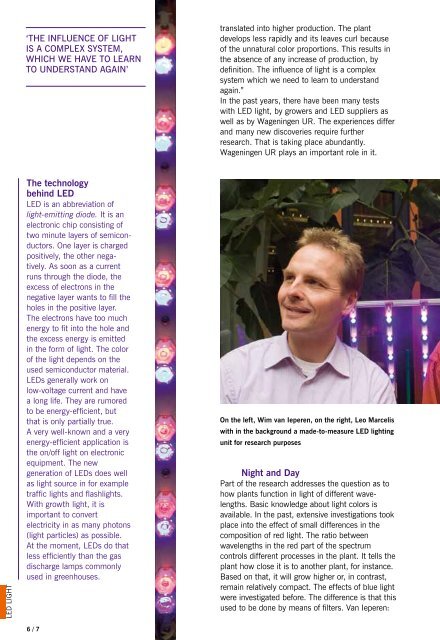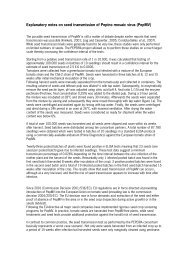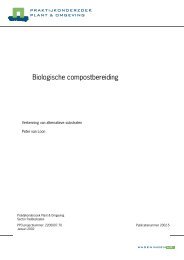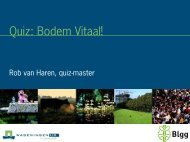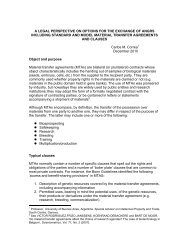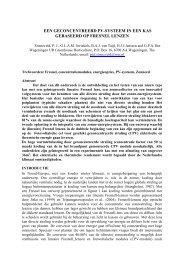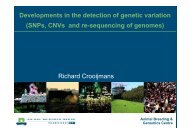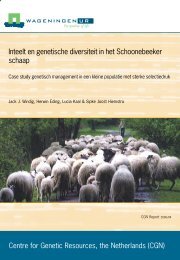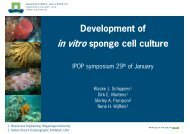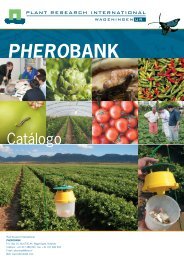wageningenupdate - Wageningen UR
wageningenupdate - Wageningen UR
wageningenupdate - Wageningen UR
Create successful ePaper yourself
Turn your PDF publications into a flip-book with our unique Google optimized e-Paper software.
‘The influence of light<br />
is a complex system,<br />
which we have to learn<br />
to understand again’<br />
translated into higher production. The plant<br />
develops less rapidly and its leaves curl because<br />
of the unnatural color proportions. This results in<br />
the absence of any increase of production, by<br />
definition. The influence of light is a complex<br />
system which we need to learn to understand<br />
again.”<br />
In the past years, there have been many tests<br />
with LED light, by growers and LED suppliers as<br />
well as by <strong>Wageningen</strong> <strong>UR</strong>. The experiences differ<br />
and many new discoveries require further<br />
research. That is taking place abundantly.<br />
<strong>Wageningen</strong> <strong>UR</strong> plays an important role in it.<br />
LED LIGHT<br />
The technology<br />
behind LED<br />
LED is an abbreviation of<br />
light-emitting diode. It is an<br />
electronic chip consisting of<br />
two minute layers of semiconductors.<br />
One layer is charged<br />
positively, the other negatively.<br />
As soon as a current<br />
runs through the diode, the<br />
excess of electrons in the<br />
negative layer wants to fill the<br />
holes in the positive layer.<br />
The electrons have too much<br />
energy to fit into the hole and<br />
the excess energy is emitted<br />
in the form of light. The color<br />
of the light depends on the<br />
used semiconductor material.<br />
LEDs generally work on<br />
low-voltage current and have<br />
a long life. They are rumored<br />
to be energy-efficient, but<br />
that is only partially true.<br />
A very well-known and a very<br />
energy-efficient application is<br />
the on/off light on electronic<br />
equipment. The new<br />
generation of LEDs does well<br />
as light source in for example<br />
traffic lights and flashlights.<br />
With growth light, it is<br />
important to convert<br />
electricity in as many photons<br />
(light particles) as possible.<br />
At the moment, LEDs do that<br />
less efficiently than the gas<br />
discharge lamps commonly<br />
used in greenhouses.<br />
6 / 7<br />
On the left, Wim van Ieperen, on the right, Leo Marcelis<br />
with in the background a made-to-measure LED lighting<br />
unit for research purposes<br />
Night and Day<br />
Part of the research addresses the question as to<br />
how plants function in light of different wavelengths.<br />
Basic knowledge about light colors is<br />
available. In the past, extensive investigations took<br />
place into the effect of small differences in the<br />
composition of red light. The ratio between<br />
wavelengths in the red part of the spectrum<br />
controls different processes in the plant. It tells the<br />
plant how close it is to another plant, for instance.<br />
Based on that, it will grow higher or, in contrast,<br />
remain relatively compact. The effects of blue light<br />
were investigated before. The difference is that this<br />
used to be done by means of filters. Van Ieperen:


